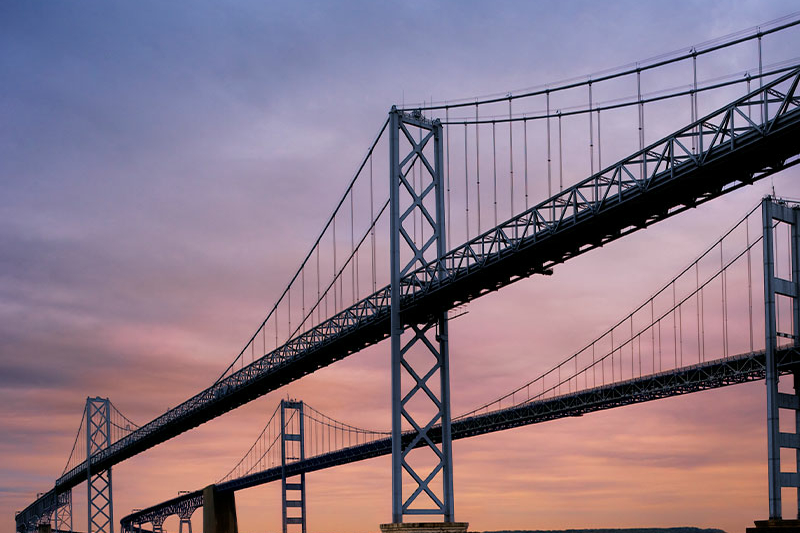US infrastructure: Plans, progress and the path to growth
The global pandemic has not dampened enthusiasm for infrastructure investment in the US. Investors and developers are looking to increase their stakes in multiple sectors and states

The US infrastructure market is at a critical juncture. President Biden's approximately US$1 trillion plan for investment in key infrastructure asset classes has attracted bipartisan support. That paves the way for large-scale spending across the country, with investment in transport, energy and power, water and digital connectivity at the center of proposals that offer the prospect of fundamental transformation.
President Biden's plans reflect a twin imperative: to renew and modernize US infrastructure, but also to provide further stimulus to the US economy as the recovery from the COVID-19 pandemic continues. The combined effect could be an unprecedented boost for the US infrastructure market.
Against this backdrop, White & Case, in association with Acuris Studios, surveyed key US infrastructure market participants—the public authorities commissioning new projects and the investors, financiers and developers who will fund, deliver and manage them. Our survey results reflect on current market sentiment, identify the opportunities that participants are prioritizing and pinpoint the challenges.
Boosted by substantial support from the Biden administration and rising demand for infrastructure investment both in the US and internationally, our research reveals that the mood is upbeat with four main findings:
1. Growth industry
Respondents see the US as a land of opportunity. Their intentions are to grow not only their investments in US infrastructure, but also the size of their teams.
2. The COVID-19 effect
While the majority state that the pandemic had a negative effect on levels of investment in US infrastructure, it also prompted respondents to consider new practices including investing in a more diverse set of assets and improving digital technology.
3. Sector watch
While transportation (in particular, roads, tunnels and bridges) is seen as the key investment sector in 2022, social infrastructure has rocketed up the agenda due to the pandemic and the growing influence of environmental, social and governance (ESG) issues.
4. A connected future
Sustainability and technology are the watchwords for respondents when it comes to futureproofing their infrastructure investments.
In the third quarter of 2021, White & Case, in partnership with Acuris Studios, surveyed 85 senior-level investors that have, or plan to, develop/fund/invest in US infrastructure, and 15 public authorities that have awarded or plan to award a PDA, DBOM, DBFOM or lease for the development or replacement of US infrastructure.
Investors surveyed included infrastructure funds, pension funds, sovereign wealth funds, sponsors, developers, institutional investors and commercial banks.
The global pandemic has not dampened enthusiasm for infrastructure investment in the US. Investors and developers are looking to increase their stakes in multiple sectors and states

While the effects of COVID-19 were unsurprisingly largely negative, the pandemic did prompt most respondents to weigh new opportunities and ways of working

The pandemic has irreversibly hastened existing trends in the world of infrastructure. Digitalization, ESG considerations and climate change are no longer side issues, they are fundamentals

Respondents are broadly optimistic about the outlook for the US infrastructure sector, but there is no room for complacency. In this final chapter, we explore funding and future plans and reveal seven key factors for infrastructure success


The pandemic has irreversibly hastened existing trends in the world of infrastructure. Digitalization, ESG considerations and climate change are no longer side issues, they are fundamentals
Stay current on your favorite topics
As the US infrastructure market accelerates, several key themes are set to dominate. One is the question of technology, with even traditional infrastructure assets now incorporating significant innovation. ESG considerations are at the fore too, particularly in the wake of the pandemic. And with the effects of climate change already being felt, this issue is also moving center‑stage.
74%
of US respondents say an increased focus on digital infrastructure is a key consideration
Both investors and commissioning public authorities are increasingly conscious of these concerns as they plan for the future. For example, 68 percent and 61 percent respectively of non-US and US respondents say sustainability is a key consideration as they weigh how to future-proof their investments. The senior managing director of a European pension fund warns: "The green credentials of projects will be key—we do not want to invest in projects that may cause potential damage to the surrounding regions or the environment at large." This is all consistent with President Biden's Build Back Better agenda that looks to address major environmental issues.
Almost three-quarters of US respondents (74 percent) point to an increased focus on digital infrastructure as a key consideration, with 55 percent of their non-US counterparts saying the same. "Demand for digital products will increase, so we have to think about the opportunities to incorporate those capabilities," says the director of M&A at one European developer.
For public authorities, the key priority is to secure cost-effectiveness, potentially through economies of scale, with 53 percent of respondents pointing to this imperative. Clearly, public authorities are determined to secure value for money as they begin to tackle the challenge of revitalizing US infrastructure.
However, other issues resonate in the same way as they do for investors. For example, 40 percent of public authorities see sustainability as a key future-proofing consideration. And 20 percent are focused on resilience to black swan events.
US$20 trillion
The amount of economic benefit smart technologies could drive in the next decade
It is convenient to separate infrastructure investment into traditional sectors—e.g., road networks or energy transmission—and emerging categories—including digital assets. But the reality is far more complex. Convergence is taking place at speed. Road networks, for example, increasingly incorporate multiple examples of smart features enabled by technology, from lane management systems to automated tolling; the energy sector is focused on new solutions in areas such as storage.
Innovations in technologies such as robotics and artificial intelligence (AI) will power the infrastructure networks of the future. And there are clear economic benefits to smart technologies such as AI and blockchain—research from ABI Research found that smart city technologies could drive more than US$20 trillion in economic benefit over the next decade.
In this context, 85 percent of investors, financiers and developers say that technology considerations are a key element in their decision-making process when they contemplate investments in US infrastructure. That includes 61 percent who describe these considerations as very important.
It is not just that stakeholders regard technological innovation as an essential part of the mix in new infrastructure projects—though this is certainly the case—but also that there is significant potential to drive value and even create new business models. For example, local public authorities and their infrastructure providers are focused on how to use digital capabilities to optimize services ranging from transport to waste collection, with a view to minimizing energy consumption and wasted time. In the energy sector, digitalization of the grid offers the prospect of a step-change in efficiency and power management.
Moreover, the ongoing trend of urbanization in the US—around 87 percent of people are expected to live in US cities by 2050, up from 75 percent in 1990—will put huge strains on the country's existing urban infrastructure. New technologies have the potential to resolve some of those strains while also supporting sustainability.
For their part, US public authorities are excited about what an increased focus on new technology and innovation could deliver for modern infrastructure. However, there are concerns about whether traditional infrastructure providers have the right skill sets to deliver digital transformation.
For this reason, more than half of the public authorities surveyed (60 percent) expect to sub-contract to a technology provider as they consider how to secure the features they want. Many (53 percent) see a key role for partnerships and joint ventures with such providers as they focus on transformation.
This may see new entrants to the US infrastructure market, or new alliances between technology providers and traditional infrastructure players. The interplay between digital and traditional assets will see hybrids emerge. The risk profile of these hybrid assets will also be interesting because there will be assets that have traditionally had a long-life risk profile that will now include a digital element; this element may have the effect of leading to an overall shorter risk horizon because technological developments related to the digital portion of the asset are likely to outpace the economic useful life of the underlying traditional infrastructure asset.
US $632 billion
Estimated investment needed in drinking water, wastewater and irrigation systems in the next decade
As the world seeks to "build back better" from the COVID-19 crisis, ESG issues will likely move center-stage. Even pre-pandemic, environmental imperatives were an increasingly important preoccupation for investors. Between 2018 and 2020, total US-domiciled assets under management using sustainable investing strategies rose to US$17.1 trillion, from US$12 trillion, according to the Forum for Sustainable and Responsible Investment's 2020 trends report.
However, the pandemic has accentuated this trend and emphasized more starkly than ever the interconnectedness of society and the fragility of our world, building awareness of key ESG issues.
Against this backdrop, investors, financiers and developers are acutely aware of the need to factor ESG considerations into their decision-making. Their ability to deliver good ESG outcomes will be a crucial determinant of the success of new infrastructure projects, both commercially and in terms of reputation and brand. Strong corporate governance and attention to the supply chain will be key.
Our survey respondents absolutely get that message. More than three-quarters describe ESG considerations as important when they are contemplating investment in US infrastructure; that includes 53 percent who regard this issue as very important. "Our investors are very clear—ESG issues are now a crucial part of our due diligence," says the director of strategy at one developer.
Moreover, respondents regard these issues as particularly pressing in the US marketplace. Some 60 percent say that ESG considerations are more important in US projects than in projects in emerging jurisdictions. "ESG has become a crucial element of our value calculations," says the head of infrastructure at a US‑based investor.
One challenge for the infrastructure market in this regard will be staying on top of numerous ESG issues simultaneously, engaging and responding on a broad range of imperatives, rather than only the most eye-catching areas of debate.
60%
of public authorities surveyed are prioritizing innovation in the context of weather riskn
In the environmental realm, 49 percent of investors, financiers and developers pick greenhouse gas emissions as a key ESG consideration. Their focus in the future will increasingly be on how to manage emissions in infrastructure projects—and to minimize their carbon footprint even in projects that rely on fossil fuels. The ongoing movement away from fossil fuels and into energy transition and renewables will only increase.
But other environmental issues will be important too. Some 45 percent of respondents single out water and waste management as a key concern—and with good reason. The Environmental Protection Agency estimates that drinking water, wastewater and irrigation systems will need US$632 billion in additional investment over the next decade.
And investors and developers are going further than just "talking the talk," with many signing up to reporting networks including the head of investment at a fund in the Asia-Pacific region who says: "We have signed the UN-backed PRI [Principles of Responsible Investing] because we know the importance of ESG and sustainable investment. When contemplating investments, we will be looking to implement these principles."
On social issues, meanwhile, the number-one ESG issue is labor standards, singled out by 46 percent (it is the largest concern by some distance—12 percentage points ahead of second-placed fair marketing and advertising). Respondents are acutely aware of the need to maintain high standards both within their own organizations and throughout the supply chain.
This focus on jobs and labor standards is particularly apt, given the emphasis on jobs and labor standards in President Biden's Infrastructure Bill and in The American Jobs Plan. Within it, there are a number of references to "strong labor standards" including, this: "The President's plan will ensure that these investments produce good-quality jobs with strong labor standards, prevailing wages and a free and fair choice to join a union and bargain collectively."
As far as many respondents are concerned, the success of the infrastructure plan will be revealed through how it affects the people. And this includes higher labor standards.
The head of finance at a US developer says: "Improving the living standards of the US population is something that would make the plan more successful. Success will not be regarded separately when projects are completed. They should benefit the population."
The G in ESG often takes a back seat to the more high-profile E and S. However, for infrastructure professionals, it is every bit as important. Poor governance practice can break a business and send investors running for the hills. As the director of infrastructure at a US pension fund says: "When contemplating investing in any infrastructure project, we have to analyze potential risk areas—good governance norms are highly important."
The top-two governance considerations in our survey both relate to good business practice. In a marketplace where contracts are often awarded by public sector authorities, 41 percent of respondents cite political influence as a key ESG consideration. This is followed by approximately a third (32 percent) who point to business ethics and transparency as their main governance consideration.
The ability to build strong relationships with elected officials and their staff without overstepping the mark will be vital. Indeed, a separate 2020 survey by Royal Bank of Canada bears this out. The bank's Global Asset Management Responsible Investment Survey found that corruption and bribery was the top ESG issue on institutional investors' minds.
While closely intertwined with the E of ESG, climate change and weather risk has reached a point where it is a category in itself—particularly for those in the infrastructure sector. The US is becoming used to the often profoundly negative impacts of climate change. From forest fires that have ravaged the country—up to July 2021, 80 wildfires had burned 1,157,976 acres in 13 states, according to the National Interagency Fire Center—to flooding in New York and surrounding areas, weather-related risk is becoming painfully obvious.
Clearly, there is significant potential for these impacts to hit key infrastructure. For investors, financiers and developers, weather risk is becoming a central calculation as they assess potential projects. "We collect weather risk data from multiple sources," explains the director of infrastructure at an Asian developer. "It has become an important part of our risk analysis."
For now, few respondents are considering pulling back from particular types of investment or regions of the country because of elevated risk. Many believe that innovation and transformation can help them manage risk, rather than forcing them to beat a retreat. Indeed, 42 percent believe a focus on innovation and technological advances can help them to accommodate climate change impacts in the US. Just 12 percent say they will only invest in states where weather risk is of less concern.
However, that may change in time, with some investors now expressing real anxiety. "The low-risk states will provide more consistent returns," says a partner in one European investment fund. "Weather risk is not the same throughout the US, and we will prefer the low-risk regions."
Public authorities, too, are well aware of the dangers of extreme weather in relation to climate change. They also see the potential for new technologies to mitigate some of the dangers—60 percent are prioritizing the focus on innovation in the context of weather risk. But many see problems as inevitable—60 percent are also determined to prioritize disaster recovery plans and other protective solutions.
And a number of respondents from public authorities state that funds need to be channeled into more environmentally friendly subsectors to counter the growing risk of climate change. "The sustainable energy generation sector is one that should be supported more," says the director of investment at one public authority. "The focus has to shift from highway development and move on to the more future-ready sectors."
It is fortunate then that renewable energy projects continue to attract significant interest, but with a significant number due to reach financial close this year and next, there may be more space for other types of infrastructure projects to catch the eye. Indeed, 73 percent of respondents believe this will likely be a positive influence on the broader infrastructure sector over the next 12 months.
Nevertheless, new renewable energy projects will continue—and investors and financiers are unlikely to be in short supply. Three-quarters of respondents (75 percent) agree that the generally lower capital cost of renewable energy projects compared to social and transport infrastructure makes them more attractive in the US; that includes almost half (49 percent) who strongly agree with this argument.
White & Case means the international legal practice comprising White & Case LLP, a New York State registered limited liability partnership, White & Case LLP, a limited liability partnership incorporated under English law and all other affiliated partnerships, companies and entities.
This article is prepared for the general information of interested persons. It is not, and does not attempt to be, comprehensive in nature. Due to the general nature of its content, it should not be regarded as legal advice.
© 2021 White & Case LLP